Oct 31, 2005
1st International Conference on Interactice Mobile and Computer aided Learning

Topics include, but are not limited, to:
- M-learning applications;
- Mobile technology support for educator and student;
- Design and development of course content;
- M-learning emerging hardware and software;
- Mobile Web and video Conferencing;
- M-learning objects and development tools;
- Service providers for mobile networks;
- M-learning standards;
- Life-long m-learning;
- Impact of m-learning on social change;
- Future trends in m-learning;
- Web and Computer-based learning;
- Tools for interactive learning and teaching;
- Platforms and authoring tools;
- New learning models and applications;
- Applications of the Semantic Web;
- Adaptive learning environments;
- Methods of content adoption;
- Project-based learning;
- Virtual campus and e-learning;
- Remote and virtual laboratories;
- Remote measurement technologies;
- Concepts for remote engineering;
- Multimedia and virtual environments;
- Cost-effectiveness
- Real world experiences
- Pilot projects / Products / Applications
For more information visit the conference web site
18:32 Posted in Positive Technology events | Permalink | Comments (0) | Tags: Positive Technology
//MUKANA
Mukana is a wearable wireless device to help the visually impaired, which connects technology with textiles. The system consists of a cell phone, a wireless headset, a Global Positioning System (GPS) module and voice recognition software. Users can ask the system to tell them their location, to give information on what route to take to their destination or on the timetables of public transportation. 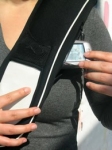 The guide system is operated with a Bluetooth® enabled wireless headset and an integrated 10-key Braille number pad for the visually impaired. Extra batteries are included to guarantee the long-term functioning of the system and the cell phone. There is a pocket where the headset can be charged and stored, as well as a pocket for keys and a wallet. The Braille keypad is located in front of the garment, rotated 90 degrees from the normal position to support ergonomic hand movement.
The guide system is operated with a Bluetooth® enabled wireless headset and an integrated 10-key Braille number pad for the visually impaired. Extra batteries are included to guarantee the long-term functioning of the system and the cell phone. There is a pocket where the headset can be charged and stored, as well as a pocket for keys and a wallet. The Braille keypad is located in front of the garment, rotated 90 degrees from the normal position to support ergonomic hand movement.
18:15 Posted in Wearable & mobile | Permalink | Comments (0) | Tags: Positive Technology, wearable
Human responses to augmented virtual scaffolding models
Ergonomics. 2005 Aug;48(10):1223-42
Authors: Hsiao H, Simeonov P, Dotson B, Ammons D, Kau TY, Chiou S
This study investigated the effect of adding real planks, in virtual scaffolding models of elevation, on human performance in a surround-screen virtual reality (SSVR) system. Twenty-four construction workers and 24 inexperienced controls performed walking tasks on real and virtual planks at three virtual heights (0, 6 m, 12 m) and two scaffolding-platform-width conditions (30, 60 cm). Gait patterns, walking instability measurements and cardiovascular reactivity were assessed. The results showed differences in human responses to real vs. virtual planks in walking patterns, instability score and heart-rate inter-beat intervals; it appeared that adding real planks in the SSVR virtual scaffolding model enhanced the quality of SSVR as a human - environment interface research tool. In addition, there were significant differences in performance between construction workers and the control group. The inexperienced participants were more unstable as compared to construction workers. Both groups increased their stride length with repetitions of the task, indicating a possibly confidence- or habit-related learning effect. The practical implications of this study are in the adoption of augmented virtual models of elevated construction environments for injury prevention research, and the development of programme for balance-control training to reduce the risk of falls at elevation before workers enter a construction job.
18:10 Posted in Virtual worlds | Permalink | Comments (0) | Tags: Positive Technology, virtual reality
Alzheimer's Art therapy
via Neurodudes
The New York Times reports about visual-art therapy, an approach which seems to have positive effects on Alzheimer's brain disease. Though it has long been known that music has beneficial effects in the rehabilitation of brain-injured patients, the potential role of visual arts has not been systematically explored so far.  According to neurologist and scientis Oliver Sacks, an aesthetic encounter is not just a visual experience, but involves the activation of emotions; further, he observes that demented patients can recognize and respond vividly to paintings, while they are scarcely responsive to words and disoriented and out of it
According to neurologist and scientis Oliver Sacks, an aesthetic encounter is not just a visual experience, but involves the activation of emotions; further, he observes that demented patients can recognize and respond vividly to paintings, while they are scarcely responsive to words and disoriented and out of it
read NYT full article
18:05 Posted in Cyberart | Permalink | Comments (0) | Tags: Positive Technology, cyberart
EMagin Z800 3DVisor Stereoscopic Headset for under $1000
via Extremetech
Good news for virtual reality therapy. eMagin offers stereoscopic headset for under $1,000.
The Z800 has 800x600 active matrix OLED displays including a pair of sharp OLED displays which supports 8 bits per pixel (16.67 million colors) and 200:1 contrast ratio. 
The price includes the head-tracker (six-degrees-of-freedom MEMS sensor, with independent gyroscopes and accelerometers for the X-Y-Z axes), a pair of stereo audio earbuds, and an integrated microphone. But the most interesting feature of the Z800 is that it is USB powered. This reduces the number of wires and gives the user more freedom of movement.
17:20 Posted in Cybertherapy | Permalink | Comments (0) | Tags: Positive Technology, virtual reality
Lost in translation? Get CMU translation goggles
via Engadget
Researchers from the International Center for Advanced Communication Technologies (interACT), a joint venture of Carnegie Mellon and the University of Karlsruhe, have developed a wearable system, which allows real-time speech translation. 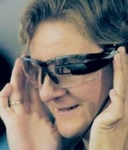 The system consists of consists of 11 electrodes that detect mouth muscle movements, translates that to a spoken language, and then re-translates that into other languages. According to comp-sci professor Alex Weibel, director of inteACT, the system still makes mistakes, he is confident that researchers will improve it significantly in the next five years. "It will make communication and cultural learning more likely" since people using this technology will be empowered to come together when they wouldn't otherwise interact, Waibel said.
The system consists of consists of 11 electrodes that detect mouth muscle movements, translates that to a spoken language, and then re-translates that into other languages. According to comp-sci professor Alex Weibel, director of inteACT, the system still makes mistakes, he is confident that researchers will improve it significantly in the next five years. "It will make communication and cultural learning more likely" since people using this technology will be empowered to come together when they wouldn't otherwise interact, Waibel said.
17:05 Posted in Wearable & mobile | Permalink | Comments (0) | Tags: Positive Technology, wearable
15th International Conference on Artificial Reality and Telexistence
(thanks Régine)
December 5th-8th, 2005, University of Canterbury, Christchurch, New Zealand
ICAT is the oldest international conference on Virtual Reality and Telexistence. ICAT 2005 will not only look for innovations in the technology itself, but also explore novel ways to transfer and express information and creative ideas to the society and people.
The 15th International Conference on Artificial Reality and Telexistence (ICAT 2005), will be held at the University of Canterbury, Christchurch, New Zealand from December 5th to 8th, 2005. Christchurch is the second largest city in New Zealand, only minutes from the sea and an hour's drive from the mountains and provides a wide range of activities in the beautiful New Zealand countryside
For further information visit the conference web site
16:23 Posted in Positive Technology events | Permalink | Comments (0) | Tags: Positive Technology
Call for Papers: Narrative AI and Games
Via the Presence Listserve
A symposium part of the AISB 2006 conference, April 5th-6th 2006, University of Bristol, Bristol, England
Submissions
Papers sought in the following areas, but are not limited to:
· Interactive narrative and virtual storytelling
· Applied AI in games
· Believable synthetic agents for games or narrative
· Agent strategy planning in a games or interactive narrative context
· The application of narrative based games in education
· The use of games as test-beds for research
Submissions should be no longer than 8 pages.
Formatting instructions will be available from the symposium website shortly
Organisers
Mr Sandy Louchart – Salford University
Dr Judy Robertson – Glasgow Caledonian University
Further information
http://www.nicve.salford.ac.uk/AISB06
15:42 Posted in Positive Technology events | Permalink | Comments (0) | Tags: Positive Technology
Oct 28, 2005
Online support helps people with chronic illnesses cope
Via BBC news
Results of a review study conducted by Elizabeth Murray and co-workers from University College London suggest that the use of interactive websites can help people with chronic illnesses such as depression, heart disease and HIV/Aids.
 The review was based on a total of 24 studies involving 3,739 participants who all had chronic (long-term) health conditions. UCL researchers looked at these patients' use of interactive computer websites and programmes, which contained information services plus online support groups, chatrooms, or tailored advice based on a person's details, affected people with such chronic diseases.
The review was based on a total of 24 studies involving 3,739 participants who all had chronic (long-term) health conditions. UCL researchers looked at these patients' use of interactive computer websites and programmes, which contained information services plus online support groups, chatrooms, or tailored advice based on a person's details, affected people with such chronic diseases.The authors of the research found that interactive sites were of greater benefit to people than those with information alone, or not using sites at all. Moreover, researchers found that such sites made patients feel better informed, more socially supported, and helped them to improve self-efficacy - a person's belief in their ability to carry out potentially-beneficial actions.
13:35 Posted in Cybertherapy | Permalink | Comments (0) | Tags: Positive Technology, virtual reality, cybertherapy
Frozen Niki
yesterday while I was visiting we-make-money-not-art I saw the picture of this strange-wearing guy

that face looked familiar to me but I could not recognize him. Then automatically popped into my head the name of my ex-colleague at Fraunhofer VR-Lab, Dragan Espenschied.
To my great surprise, I discovered that Dragan has become a world-famous electronic music artist as well as a respected media artist. These pictures are part of one of his last works, Frozen Niki
Frozen Niki is a story of this cosmonaut, organized in the form of a blog without text and has to be read from bottom up to follow his fragmentary thoughts and a detective love story:
“… and now a few words about one of the most important members of the intergalactic expedition, Nikolaj Osinin. He will not be able to participate in the everyday life of the mission. He has his own mission: to remain young and fit until the spaceship Zvezdostella reaches the Magellanic Clouds, to perform his tasks upon arrival then pilot the ship back to the Milky Way and finally to Earth. He’ll spend the next 20 years in a cryogenic box. But he will be with us. His brain activity will be monitored by the Central Mission Computer. In due course Nikolaj’s cranium will be stablized at the -20°C mark and data transmission to the Bajkanur server will be initiated and fed immediately via the Internet to Nikolaj’s personal blog.”
compliments Dragan!!
12:56 Posted in Cyberart | Permalink | Comments (0) | Tags: Positive Technology
Touch the music
via wired
The Vibrato, a prototype developed by design graduate Shane Kerwin from Brunel University,  converts music into vibrations that allow the deaf to listen to and create music via a PC.
converts music into vibrations that allow the deaf to listen to and create music via a PC.
"I hope that Vibrato will help us to integrate deaf students into mainstream musical education and enable schools to encourage deaf children to take up music as much as hearing children" said Kervin (source: BBC news)
00:40 | Permalink | Comments (0) | Tags: Positive Technology
Oct 26, 2005
Deliver PubMed search results with an RSS feed

To add PubMed searches to your collection of RSS feeds, just follow these steps:
| (1) Run your search in PubMed. | |
| (2) Select RSS Feed from the Send to menu. | |
| (3) Click Create Feed and copy the XML icon into your RSS Reader. |
18:30 Posted in Research tools | Permalink | Comments (0) | Tags: Positive Technology, research tools
Gulliver's Box
Gulliver's Box, developed by Mixed Reality Lab, the Human Interface Lab of Osaka, the Ars Electronica Futurelab and Zaxel, is a mixed reality theatrical application which allows users to modify characters and give specific features to them. The environment can be revised and customized according to the desires of the users each time. In dealing with the individual interfaces, players are introduced into mixed reality environments on different levels of interaction.
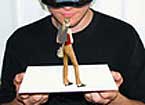
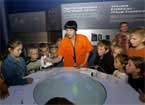

Gulliver's Box has won a mention at the World Summit Award
17:00 Posted in Augmented/mixed reality | Permalink | Comments (0) | Tags: Positive Technology, Augmented/mixed reality
Theta brainwave triggered training boosts old brains
It has long been known that hippocampus is involved in the learning process. A study published on the Proceedings of the National Academy of Science (USA) has shown that theta brainwave triggered training can enhance learning rate in old rabbits, contrasting the deficit determined by the aging process. This study could have important implications in the development of nonpharmacological treatments for age-related memory deficits.

Nonpharmacological amelioration of age-related learning deficits: The impact of hippocampal  -triggered training
-triggered training
 rhythm, is known to enhance hippocampal plasticity and accelerate learning rate in young subjects, suggesting that manipulations of
rhythm, is known to enhance hippocampal plasticity and accelerate learning rate in young subjects, suggesting that manipulations of  activity might be used as a means to counteract impairments related to the aging process. Here, young and older rabbits were given eyeblink conditioning trials either when exhibiting hippocampal
activity might be used as a means to counteract impairments related to the aging process. Here, young and older rabbits were given eyeblink conditioning trials either when exhibiting hippocampal  (
( +) or regardless of hippocampal activity (yoked control). Although, as expected, older-yoked control animals showed a learning deficit, the older
+) or regardless of hippocampal activity (yoked control). Although, as expected, older-yoked control animals showed a learning deficit, the older  + group learned as fast as young controls, demonstrating that aging deficits, at least in eyeblink classical conditioning, can be overcome by giving trials during episodes of hippocampal
+ group learned as fast as young controls, demonstrating that aging deficits, at least in eyeblink classical conditioning, can be overcome by giving trials during episodes of hippocampal  activity. The use of several learning criteria showed that the benefits of hippocampal
activity. The use of several learning criteria showed that the benefits of hippocampal 
 -triggered training in both age groups during the early phase of acquisition, the enhancement persisted in older animals, peaking during later performance. These findings have implications for theories of age-related memory deficits and may contribute to the development of beneficial treatments. depend on different cognitive or motor processes. Whereas there was a benefit of
-triggered training in both age groups during the early phase of acquisition, the enhancement persisted in older animals, peaking during later performance. These findings have implications for theories of age-related memory deficits and may contribute to the development of beneficial treatments. depend on different cognitive or motor processes. Whereas there was a benefit of16:35 Posted in Mental practice & mental simulation | Permalink | Comments (0) | Tags: Positive Technology, mental practice, motor imagery
Technological innovations in clinical assessment and psychotherapy
Psychother Psychosom. 2005;74(6):336-43
Authors: Emmelkamp PM
In this paper the application of computer technology and the use of the Internet in mental health care are critically reviewed. A number of on-line screening devices have been developed for anxiety disorders, mood disorders, and substance abuse disorders, with great potential for clinical practice. On line assessment is generally equivalent to clinical assessment. A number of studies have shown that self-help treatment programmes on stand-alone computers are as effective as routine clinical care. The Internet enhances the therapeutic possibilities of computers by offering feedback of therapists and more tailor-made treatment. A number of randomized clinical trials (RCTs) have shown that Internet-based treatment is more effective than no-treatment and as effective as face-to-face treatment. Research so far has been limited to anxiety disorders, burn-out, depression, headache, insomnia, tinnitus and obesity. Further, exposure through virtual reality has been found effective in a number of RCTs in specific phobias, but results with respect to the effects of the use of virtual reality techniques to other disorders are inconclusive. It is concluded that computer-driven assessment and treatment has many advantages and few disadvantages. A number of reasons are discussed which will preclude large-scale implementation of computer-driven assessment and therapy in the near future.
PMID: 16244509 [PubMed - in process]
16:05 Posted in Cybertherapy | Permalink | Comments (0) | Tags: Positive Technology, virtual reality, cybertherapy
Visual Art & the Brain Conference
Via BrainBlog
The conference Visual Art & the Brain: At the Interface of Art and Science will be held at the City University of New York (CUNY) November 5, 2005. The goal of the conference is to explore the link between science and art.

This conference will explore the nature of the science-art interface, the inspiration this interface provides to scientists and artists alike, and the impact of such interactions on areas of research and other human endeavors. The morning session will explore scientific perspectives: What is vision? How do we perceive art and why do we respond to it emotionally? The afternoon session will focus on the interface of art and science, and will feature discussions with artists and scientists on communicating the beauty and power of science as well as its social and ethical implications. This event is suitable for scientists interested in art, and artists interested in science.
For more information, visit the conference web site
15:47 Posted in Positive Technology events | Permalink | Comments (0) | Tags: Positive Technology
Oct 25, 2005
Aibo to fight obesity
Via Medical Informatics Insider
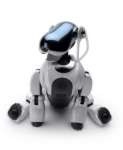 The canine robot would be able to monitor daily food intake and exercise levels and encourage overweight individuals to stick to their diets. The dog would be connected by radio to the bathroom scales, a pedometer and a personal organizer in which the owner would note his daily food intake.
The canine robot would be able to monitor daily food intake and exercise levels and encourage overweight individuals to stick to their diets. The dog would be connected by radio to the bathroom scales, a pedometer and a personal organizer in which the owner would note his daily food intake.More to explore
MIT Media LabAIBO, Sony
UbiComp
17:20 Posted in AI & robotics | Permalink | Comments (0) | Tags: Positive Technology, robotics
HHS Awards $17.5 Million to Advance Health IT
Telemedicine Insider reports that the Health and Human Services Department has awarded three contracts totaling $17.5 million to public-private groups to accelerate the adoption of health IT and the secure portability of health data. HHS will award contracts for development of prototypes for a nationwide health information network later this month or in early November.
17:04 Posted in Research institutions & funding opportunities | Permalink | Comments (0) | Tags: Positive Technology
Portable augmented reality
Via we-make-money-not-art, TRN
Microsoft researcher Andrew D. Wilson has developed a portable augmented reality system that uses a projector and computer vision technology to display interactive images on any surface such as floors, white board and walls. The system, called PlayAnywhere, is a single portable unit and does not need mounted cameras. Further, the system does not require calibration. 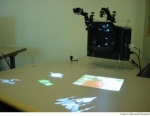 Besides edutainment applications, this portable AR system could have interesting applications in the field of neurorehabilitation of brain-injured patients. I have used a similar approach in the project I-Learning. In this project, we developed an augmented-reality display to guide physical and mental practice exercises for patients with upper-limb hemiplegia following stroke.
Besides edutainment applications, this portable AR system could have interesting applications in the field of neurorehabilitation of brain-injured patients. I have used a similar approach in the project I-Learning. In this project, we developed an augmented-reality display to guide physical and mental practice exercises for patients with upper-limb hemiplegia following stroke.
PlayAnywhere: A Compact Interactive Tabletop Projection-Vision System, Symposium on User Interface Software and Technology (UIST 2005), Seattle, October 23-26, 2005 PDF
16:50 Posted in Augmented/mixed reality | Permalink | Comments (0) | Tags: Positive Technology, Augmented/mixed reality
Neurobiology of the self on Scientific American
Via Brain Blog
The November 2005 issue of Scientific American publishes an article by Carl Zimmer entitled "The Neurobiology of the Self". This is the abstract:
The most obvious thing about yourself is your self. "You look down at your body and know it's yours," says Todd Heatherton, a psychologist at Dartmouth University. "You know it's your hand you're controlling when you reach out. When you have memories, you know that they are yours and not someone else's. When you wake up in the morning, you don't have to interrogate yourself for a long time about who you are." The self may be obvious, but it is also an enigma. Heatherton himself shied away from direct study of it for years, even though he had been exploring self-control, self-esteem and other related issues since graduate school. "My interests were all around the self but not around the philosophical issue of what is the self," he explains. "I avoided speculations about what it means. Or I tried to, anyway."
16:15 Posted in Telepresence & virtual presence | Permalink | Comments (0) | Tags: Positive Technology, Presence






